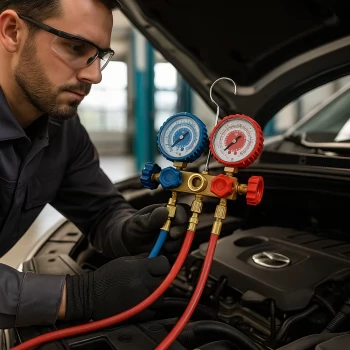When the summer heat hits and your car's air conditioning isn't blasting that refreshingly cool air like it used to, you might be wondering: "How often should I recharge my car's AC?" It's a common question that many vehicle owners face, especially as temperatures rise or when they notice their AC system isn't performing as well as it once did.
Understanding Your Car's AC System: The Basics
Your vehicle's air conditioning system is a closed system that relies on refrigerant (commonly known as Freon, though modern cars use R-134a or the newer R-1234yf) to cool the air. Unlike engine oil or other fluids, refrigerant isn't meant to be consumed during normal operation—it continuously cycles through the system.
In an ideal world, you would never need to recharge your car's AC system because the refrigerant should remain sealed within the system indefinitely. However, real-world conditions are rarely ideal.
The Truth About AC Recharging: It's Not Regular Maintenance
A properly functioning AC system should not require regular recharging.
This is perhaps the most important fact to understand: Unlike oil changes or tire rotations, AC recharging is not a scheduled maintenance task. If your system needs refrigerant, it means there's a leak somewhere in the system.
According to Mark Johnson, certified automotive technician with 25 years of experience, "If your car's AC system is losing refrigerant, that's a symptom of a problem, not a normal condition that requires periodic service."
How Often Do AC Systems Actually Need Recharging?
A well-maintained air conditioning system in a modern vehicle might never need recharging during the car's lifetime. However, as cars age, seals can deteriorate and components can develop small leaks.
Here's a general guideline:
- New cars (1-5 years old): Should not need recharging if the system is functioning properly
- Mid-age vehicles (5-10 years): May begin to lose small amounts of refrigerant through microscopic leaks at connection points
- Older vehicles (10+ years): More likely to need recharging due to normal wear and tear on components and seals
According to a survey by the Automotive Service Association, approximately 10-15% of vehicles between 4-8 years old will develop AC system leaks that require repair and recharging.
Signs Your Car's AC System Needs Attention
Rather than wondering about a recharge schedule, pay attention to these indicators that your AC system might need service:
- Decreased cooling performance: Your AC no longer blows as cold as it once did
- Cooling that starts strong but quickly fades: Often indicates a low refrigerant level
- AC clutch not engaging: You might notice the compressor (visible at the front of the engine when the hood is open) isn't turning on
- Unusual noises when the AC is running: Could indicate problems with the compressor or other components
- Visible refrigerant leaks: Often appearing as oily residue around AC components or connections
Why You Should Address AC Issues Promptly
When your car's AC system is low on refrigerant, it's not just a comfort issue—continuing to run the system with insufficient refrigerant can cause serious and expensive damage.
"Running an AC system that's low on refrigerant can damage the compressor, which is the heart of the system and the most expensive component to replace," explains Sarah Chen, automotive engineering specialist. "What might have been a simple $200 repair can quickly become a $1,000+ job."
The Professional Inspection Approach
Instead of asking how often to recharge your AC, the better approach is to have your vehicle's AC system professionally inspected:
- Every 2-3 years for newer vehicles
- Annually for vehicles over 5 years old
- Immediately if you notice any decrease in cooling performance
A professional inspection typically includes:
- Performance test: Measuring how cold the air gets and how quickly
- Pressure test: Checking if the system is maintaining proper pressure
- Leak detection: Using specialized equipment to locate even tiny leaks
- Visual inspection: Examining components for wear or damage
The DIY Temptation: AC Recharge Kits
Many auto parts stores sell DIY AC recharge kits that include refrigerant and a gauge. While these can temporarily restore cooling performance, they come with significant drawbacks:
- They don't fix the underlying leak
- They don't include proper leak detection
- Incorrect usage can introduce air or overcharge the system
- You might be masking a more serious problem
"DIY recharge kits are like putting a band-aid on a broken arm," says Tony Martinez, owner of Coolmax Auto Service. "They might provide temporary relief, but they're not solving the real problem."
Environmental and Legal Considerations
Refrigerant is a controlled substance due to its environmental impact. The Clean Air Act makes it illegal to intentionally release refrigerants into the atmosphere, and proper handling requires certification.
Modern refrigerants like R-1234yf have been developed specifically to reduce environmental harm compared to older types, but they still require proper handling.
Cost Factors: Prevention vs. Repair
The financial aspect of AC maintenance is worth considering:
- Professional AC inspection: $50-150
- Minor leak repair and recharge: $200-500
- Major system repair (compressor replacement): $800-1,500
Regular inspections that catch small leaks early can save significant money compared to waiting until the system fails completely.
Step-by-Step Guide: What to Do When Your AC Isn't Cooling
If you're experiencing AC problems, here's a practical approach:
- Verify basic operation: Make sure the blower is working and the temperature control is set correctly
- Check for simple issues: Inspect the cabin air filter, which if clogged can reduce airflow
- Consult your maintenance schedule: Some manufacturers include AC system checks at specific intervals
- Visit a qualified technician: Preferably one with ASE certification in heating and air conditioning (ASE certification H7)
- Get a complete diagnosis: Don't just ask for a recharge; request a full system evaluation
- Address all identified issues: Fix leaks and damaged components before recharging
- Consider the value proposition: For older vehicles, weigh repair costs against the vehicle's value
The Technology Evolution: Modern AC Systems
Car AC technology continues to evolve, with newer systems designed for greater efficiency and reliability:
- Electronic leak detection: Modern shops can detect leaks as small as 0.1 ounces per year
- Improved sealing technology: Newer vehicles use better materials that resist deterioration
- Variable displacement compressors: Adjust output based on demand, reducing wear
- Automatic climate control: More sophisticated systems that can identify problems earlier
Seasonal Considerations for AC Maintenance
Your climate and usage patterns affect AC system longevity:
- Hot climate regions: Systems work harder and may develop issues sooner
- Cold climate regions: Systems that sit unused for months may develop seal problems
- High-mileage drivers: More operating hours means more wear on components
- Low-mileage drivers: Lack of regular use can cause seals to dry out
Beyond Recharging: Comprehensive AC Care
Maintaining optimal AC performance involves more than just refrigerant levels:
- Cabin air filter replacement: Typically every 15,000-30,000 miles
- Condenser cleaning: Removing debris that restricts airflow
- Belt inspection: Checking the serpentine belt that drives the compressor
- Electrical system check: Ensuring proper voltage to AC components
Expert Recommendations: Industry Consensus
The Society of Automotive Engineers (SAE) and most vehicle manufacturers agree on these best practices:
- Don't treat recharging as regular maintenance
- Always repair leaks before recharging
- Have the system professionally evacuated and recharged
- Use only the specified type and amount of refrigerant
- Include a receiver/drier replacement with major system work
Conclusion: The Right Approach to AC Maintenance
So, how often should you recharge your car's AC? The answer is: only when necessary due to a confirmed refrigerant leak. Instead of focusing on recharging, adopt these best practices:
- Pay attention to performance: Act quickly if cooling effectiveness decreases
- Maintain the entire system: Address all components, not just refrigerant levels
- Trust qualified professionals: AC work requires specialized knowledge and equipment
- Fix root causes: Don't just top off refrigerant without addressing why it's low
- Consider preventive inspections: Regular checks can catch problems before they become serious
By understanding that your car's AC system is designed to be sealed and shouldn't need regular recharging, you'll save money, prevent major repairs, and enjoy reliable cooling for years to come.
Frequently Asked Questions
Q: Is it normal for a car to need AC recharging every summer? A: No, this indicates a leak that should be repaired. A properly functioning system should maintain its refrigerant level indefinitely.
Q: How much does a professional AC recharge cost? A: Typically $150-300, including diagnosis and the refrigerant itself. Costs vary by location and vehicle type.
Q: Can I just add more refrigerant without fixing the leak? A: While technically possible, it's not recommended. You'll continue to lose refrigerant, and running the system when low can damage expensive components.
Q: How do I know if my car uses R-134a or R-1234yf refrigerant? A: Check the label under the hood or consult your owner's manual. Using the incorrect type can damage your system and is illegal.
Q: Can extreme temperature changes cause my AC to need recharging? A: Temperature fluctuations alone shouldn't cause refrigerant loss. If levels are dropping, there's a leak that needs attention.
Remember that professional diagnosis is the key to addressing AC issues correctly the first time, saving you money and ensuring your comfort during hot weather driving.




